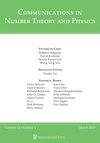丢番图方程的和立方和立方的和
IF 1.2
3区 数学
Q1 MATHEMATICS
引用次数: 0
摘要
我们求解类型为$a(x^3+y^3+z^3)=(x+y+z)^3$的丢芬图方程,其中$x$, $y$, $z$为整数变量,系数$a \neq 0$为有理数。我们证明有无限的这样的方程族,包括$a$是任意立方体或某些有理数的方程族,它们具有非平凡解。也有无限的方程族没有任何非平凡解,包括那些$1/a=1-24/m$对整数$m$有限制的方程族。方程可以用椭圆曲线表示,除非$a=9$或$1$,对于$k=2,3,4$或$\mathbb{Z}/2\mathbb{Z} \times \mathbb{Z}/6\mathbb{Z}$,任何非零的$j$ -不变量和扭转群$\mathbb{Z}/3k\mathbb{Z}$的椭圆曲线对应于一个特定的$a$。证明了对于任意$a$,非平凡解的个数不超过$3$或无穷大,对于整数$a$,非平凡解的个数不超过$0$或$\infty$。对于$a=9$,我们找到了通解,它依赖于两个整数参数。这些三次方程在粒子物理学中很重要,因为它们决定了$U(1)$规范群下的费米子电荷。本文章由计算机程序翻译,如有差异,请以英文原文为准。
Diophantine equations with sum of cubes and cube of sum
We solve Diophantine equations of the type $a(x^3+y^3+z^3)=(x+y+z)^3$, where $x$, $y$, $z$ are integer variables, and the coefficient $a \neq 0$ is rational. We show that there are infinite families of such equations, including those where $a$ is any cube or certain rational fractions, that have nontrivial solutions. There are also infinite families of equations that do not have any nontrivial solution, including those where $1/a=1-24/m$ with restrictions on the integer $m$. The equations can be represented by elliptic curves unless $a=9$ or $1$, and any elliptic curve of nonzero $j$-invariant and torsion group $\mathbb{Z}/3k\mathbb{Z}$ for $k=2,3,4$, or $\mathbb{Z}/2\mathbb{Z} \times \mathbb{Z}/6\mathbb{Z}$ corresponds to a particular $a$. We prove that for any $a$ the number of nontrivial solutions is at most $3$ or is infinite, and for integer $a$ it is either $0$ or $\infty$. For $a=9$, we find the general solution, which depends on two integer parameters. These cubic equations are important in particle physics, because they determine the fermion charges under the $U(1)$ gauge group.
求助全文
通过发布文献求助,成功后即可免费获取论文全文。
去求助
来源期刊

Communications in Number Theory and Physics
MATHEMATICS, APPLIED-MATHEMATICS
CiteScore
2.70
自引率
5.30%
发文量
8
审稿时长
>12 weeks
期刊介绍:
Focused on the applications of number theory in the broadest sense to theoretical physics. Offers a forum for communication among researchers in number theory and theoretical physics by publishing primarily research, review, and expository articles regarding the relationship and dynamics between the two fields.
 求助内容:
求助内容: 应助结果提醒方式:
应助结果提醒方式:


